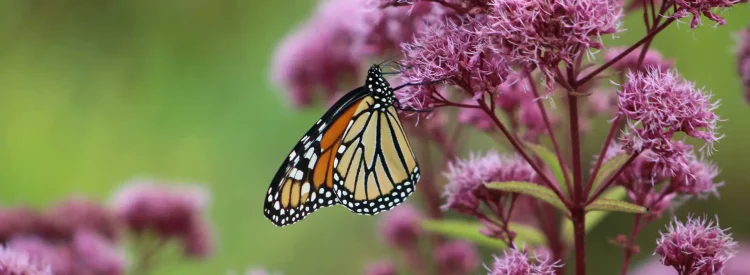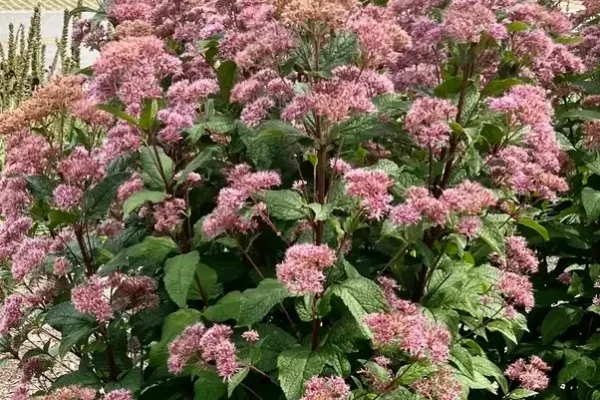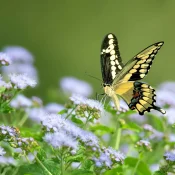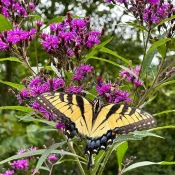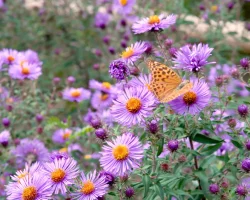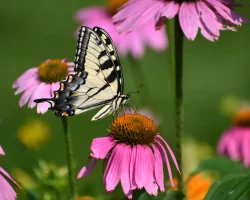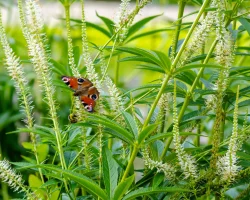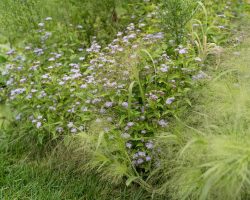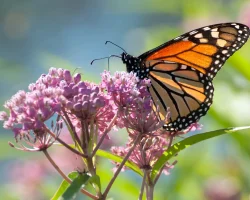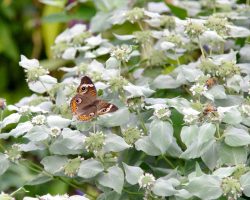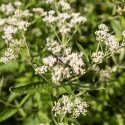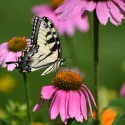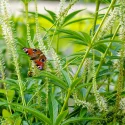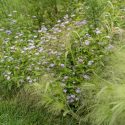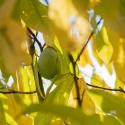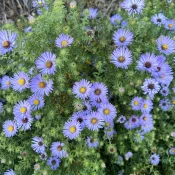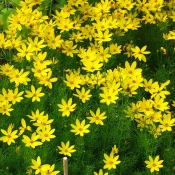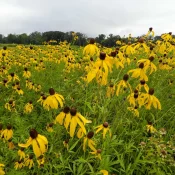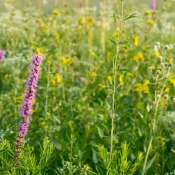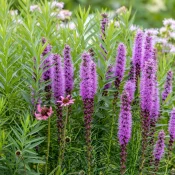These late-blooming native plants offer crucial pollen and nectar towards the end of the summer when many other flowers have stopped blooming. Joe Pye weed has one of the most confusing common names for a plant—who is Joe Pye, and why would I want to plant a weed? Scroll on to meet Joe Pye—both the plant, and the man.
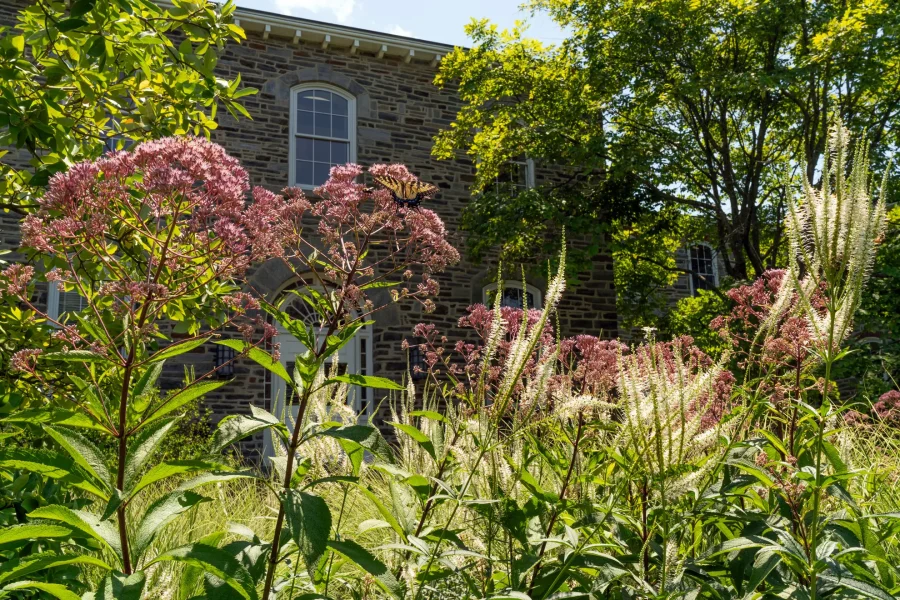
Is Joe Pye weed a good choice for my yard?
Yes, if…
- You want a towering late-season nectar source for pollinators.
- You have space for tall plants (4–10′) at the back of a border or meadow…or pick a shorter cultivar.
- You like a plant that thrives with little maintenance once established.
- You want to add history and story to your garden conversations.
Why Joe Pye weed matters
- Pollinator lifeline: Feeds bees, butterflies, and migrating Monarchs at a critical time.
- Low-maintenance: Thrives on rainfall once established.
- Living history: Named after Joseph Shauquethqueat, a Mohican leader whose story deserves to be told.
And one more benefit:
All species of Joe Pye weed are host plants
Every Joe Pye weed species is a host plant for 35+ species of moth and butterfly caterpillars, including ruby tiger moths and clymene moths.
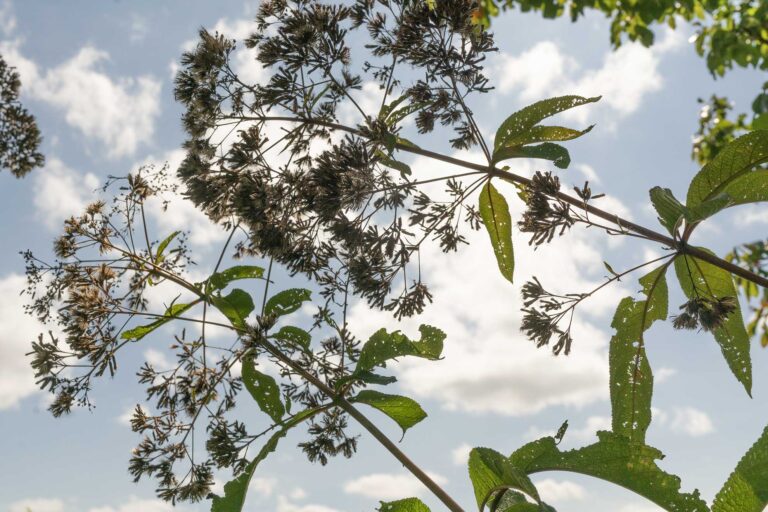
New to native?
Before lawns and landscaping, native plants were here. They’ve fed birds, bees, and butterflies for thousands of years—and they’ll do the same in your yard. The best part? They’re easier to grow than you think.
Now that we’ve given reasons why to plant Joe Pye weed, let’s get right to the big question:
Who is Joe Pye?
Joe Pye weed might have the strangest common name in the native plant world. (You can judge for yourself and read our Strange Names for Beautiful Native Plants.) For centuries, botany books vaguely described Joe Pye as “an Indian herbalist” or a “wandering medicine man” who lived somewhere on the eastern seaboard in the 1600s. The problem? Nobody could pin him down. Maine, South Carolina, maybe somewhere in between…it was a swirl of regional folklore.
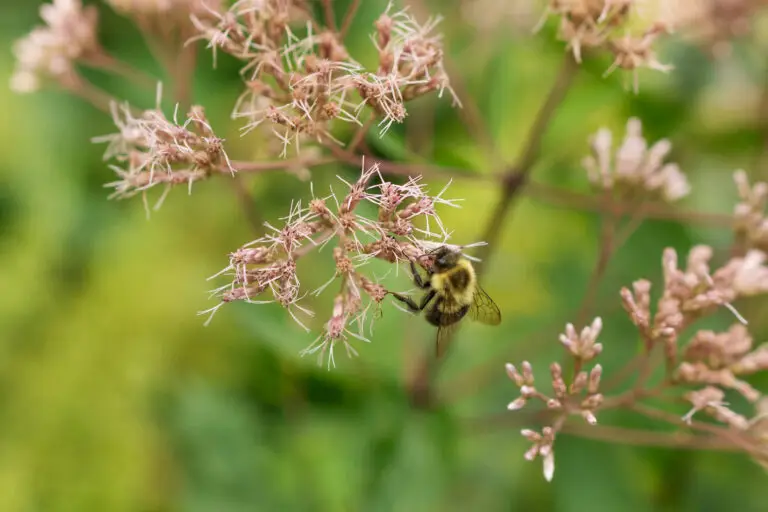
The real Joe Pye has been found
The real Joe Pye finally came into focus in 2017, thanks to a peer-reviewed paper in the University of Michigan’s Great Lakes Botanist. Researchers traced the name to Joseph Shauquethqueat, an 18th- and early 19th-century Mohican sachem (chief) who lived in the Northeast:
“Discrepancies have long existed as to the race of the man for whom Joe-Pye-weed was named, the century and the part of the country in which he lived, and even whether the plant name was derived from the name of any person, real or fictional. Our investigation has indicated that this plant name is from the cognomen of Joseph Shauquethqueat, an 18th- and early 19th-century Mohican sachem, who lived successively in the Mohican communities at Stockbridge, Massachusetts, and New Stockbridge, New York.” (Source)
Joseph Shauquethqueat—or Joe Pye—needs a Hollywood movie. (We promise you this is worth reading. However, if you’re looking for planting tips, find them in ~2 scrolls. )
Let’s meet Joe.
Joseph Shauquethqueat was born in 1722 into the Mohican community near present-day Albany, New York. Colonists shortened his surname to “Pye,” a common practice when Indigenous leaders signed documents.
As a young man, he and his Mohican community were forced to relocate to Stockbridge, Massachusetts, a so-called “reward” from the colonists for siding with the British during the French and Indian War.
This “reward” was a sham. White settlers encroached, racist laws stripped property rights, and the Mohicans struggled to survive.
Joe becomes Chief Sachem
By 1777, Shauquethqueat was elected Chief Sachem. He appealed directly to the Massachusetts government for what was promised, writing: “we and our fathers had once been the rightful possessor of all your Country.” His letters went unanswered. By 1785, impoverished and disenfranchised, the Stockbridge Mohicans were pressured to sell off most of their land and began moving west to what’s now Madison and Oneida counties, New York.
Shauquethqueat didn’t trust the government for this second move.
He turned to another ally: the Oneida Nation, who offered the land. And in an extraordinary twist, he also wrote to George Washington himself.
Yes, that George Washington
Picking up and moving an entire community is a miracle, especially one with a target on its back. Shauquethqueat needed protection.
On July 2, 1783, Shauquethqueat wrote to a white leader asking for protection: George Washington. Washington wrote back that the Mohicans had “remained firmly attached to us, [and had] fought and bled by our side…consider them as friends and subjects to the United States of America.”
The letter helped deliver safe passage to New York—a tiny bit of light against generations of violence and disenfranchisement.
The name Joe Pye weed came from European settlers, who used a name they knew and respected for a plant they depended on.
So, how did the plant get named for ‘Joe Pye’?
Within Indigenous communities, Joe Pye weed was long used medicinally to reduce fevers. Colonists, desperate for remedies, came to rely on it too.
This medicinal plant needed a memorable and trustworthy name.
The name Joe Pye weed came from European settlers, who used a name they knew and respected for a plant they depended on.
Plant for beauty and to honor Joseph Shauquethqueat’s legacy
Planting Joe Pye weed today isn’t just about tall purple blooms or pollinator gardens. It’s about remembering Joseph Shauquethqueat—a leader whose story is too often untold—and honoring the Indigenous knowledge that shaped our landscapes long before lawns and garden centers.
(Read about pawpaw trees and boneset for other movie-worthy native plant backstories.)

There are several species of Joe Pye weed
Joe Pye weed is the common name for several species of plants within the Eupatorium genus. Each plant has pink-purple blooms and is a butterfly favorite. The main difference between species is seen in their height. Here they are, from tallest to shortest:
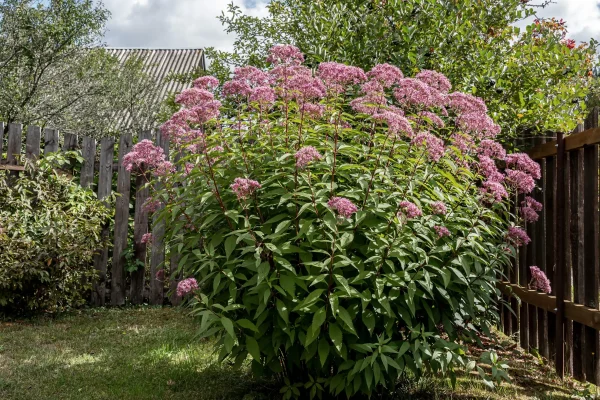
Hollow Joe Pye Weed
Eupatorium fistulosum
This is the tallest, growing up to 10 FEET. Native from Quebec all the way to Texas.
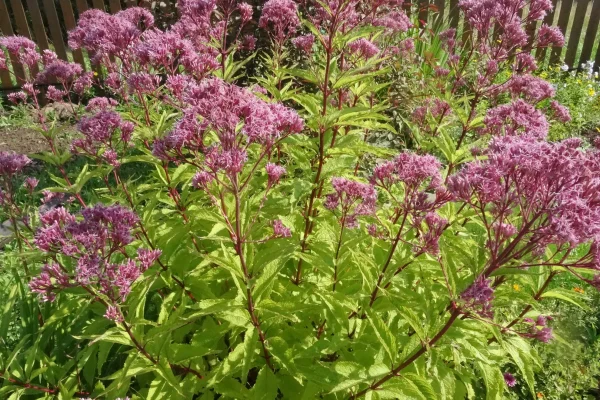
Sweetscented Joe Pye Weed
Eupatorium purpureum
A little shorter—but not short! 6′ tall with good-smelling leaves. Native from Quebec all the way to Florida.

Spotted Joe Pye Weed
Eupatorium maculatum
6′ tall with dotted stems. This species has the largest, most extensive native range, spanning from New Brunswick to British Columbia in Canada, and extending down to Arizona. It’s native to 75% of North America.
Coastal Plain Joe Pye Weed
Eupatorium dubium
This is the shortest at 4′ tall, and it thrives in chilly northern climates. Native to the Northeastern seaboard, from Nova Scotia to South Carolina.
Are these too tall for you? Try a Joe Pye weed cultivar.
A cultivar is a plant that has been selected or bred by humans (here is a short cultivar overview.) There are also some shorter cultivars, including ‘Baby Joe’, which tops out at 2′ tall.
How to grow Joe Pye weed
Joe Pye weed is one of the easiest native perennials to grow. Just give it some sun and space, and it’ll do the rest.
Plant it in full to part sun for the best blooms. It thrives in moist, well-drained soil, but it’s also surprisingly adaptable—once established, it can handle drier spots too. If you’ve got an area that stays damp after rain or near a downspout, Joe Pye weed will be perfectly at home there.
Where Joe Pye weed shines in your yard
Think of Joe Pye weed as your garden’s skyscraper. Plant it at the back of beds for height, or cluster several together for a meadow effect. Its dusky purple flowers pair beautifully with yellow bloomers like goldenrods or black-eyed susans. Alongside grasses, coneflowers, and asters, it creates that sweeping, layered look you see in prairie restorations, but right in your yard. These plants also look incredible in groups, where their tall, purple-pink flower clusters create a dramatic backdrop for shorter native flowers and grasses.
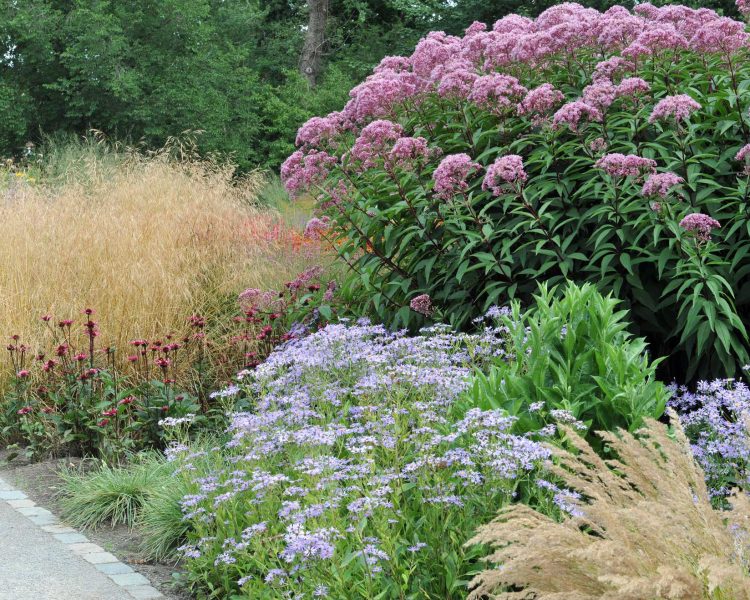
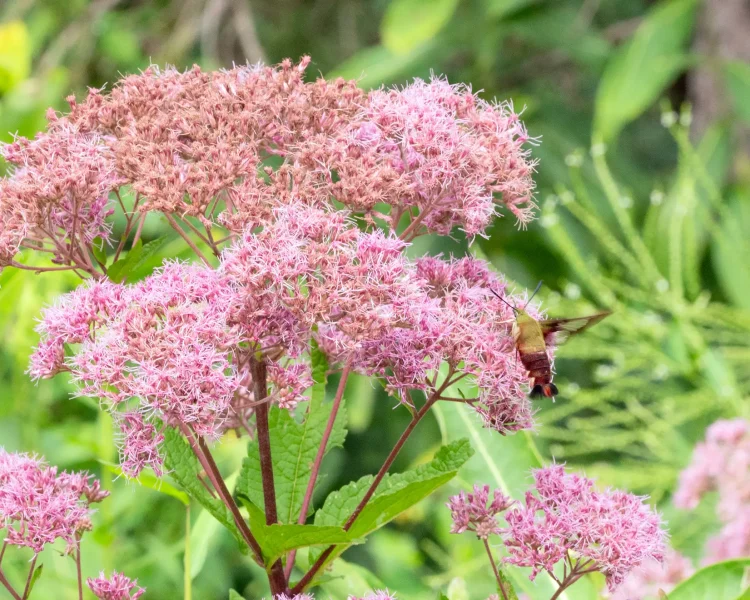
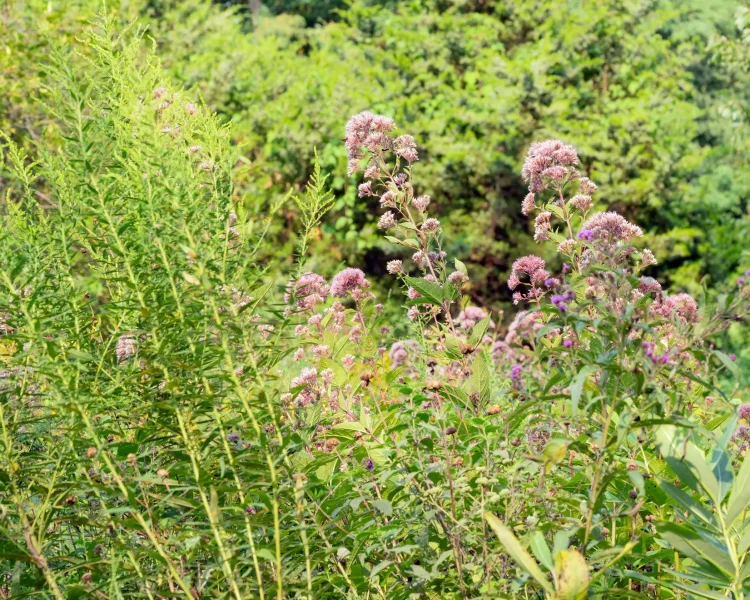
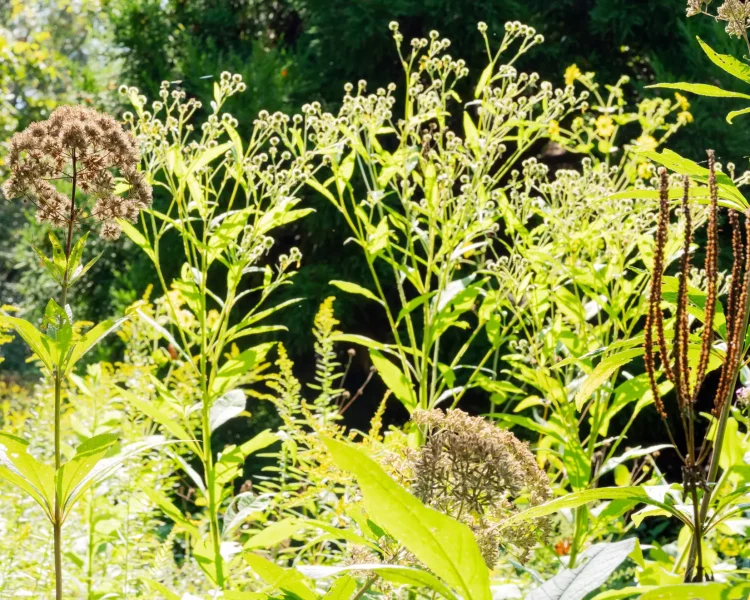
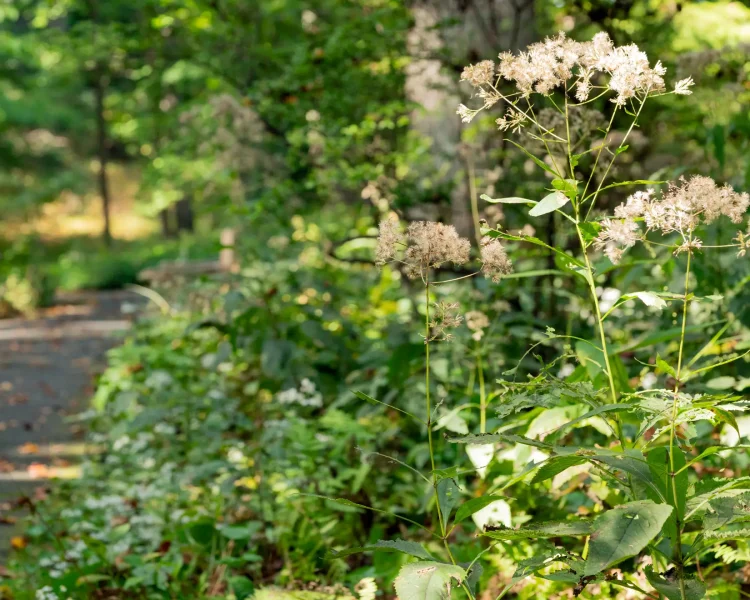
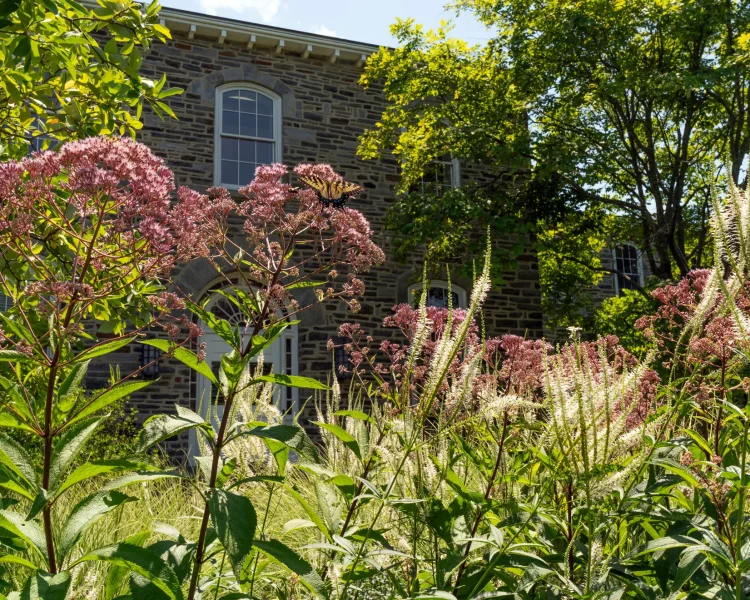
Native flowers similar to Joe Pye weed
There are a few other natives that look similar to Joe Pye weed, with different coloring and heights:
Where can I find Joe Pye weed?
To find a specific native plant, visit a native nursery that specializes in them. (Big-box stores don’t often carry natives like Joe Pye weed.) Here are four sourcing resources to make finding one for your garden easy:
Where can I find seeds and plants?
Finding native plants can be challenging (we partly blame Marie Antoinette.) To make it easier, we’ve assembled four sourcing ideas.
300+ native nurseries make finding one a breeze
Explore 100+ native-friendly eCommerce sites
Every state and province has a native plant society; find yours
Online Communities
Local Facebook groups are a great plant source
What are good Joe Pye weed pairings?
There are so many native gems that pair well with Joe Pye. We’ve picked a few recommendations below that offer flowers at different parts of the growing season, so pollinators have lots of food and shelter.
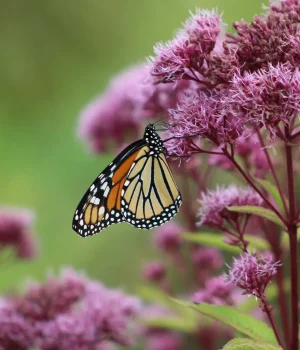
Pairs well with
To sum it all up, Joe Pye weed is more than a pollinator powerhouse—it’s a living story. Plant it for towering blooms, migrating butterflies, and to honor Joseph Shauquethqueat’s legacy. Add a garden nametag and share the history when neighbors ask, “Who is Joe Pye?” Meet other native plants with incredible backstories by visiting our guides to boneset, coneflowers, or magnolias. Or, keep exploring host plants and visit our Best Native Host Plants round-up. Happy planting!
Sources
- Pearce, Richard and Pringle, James. Joe Pye Weed: The History and Eponymy of the Common Name. The Great Lakes Botanist, 2017.
- The New York Times, How Joe Pye Gave His Name to a Weed. Joan Lee Faust,
- Johnson, Lorraine. 100 Easy-to-Grow Native Plants for American Gardens in Temperate Zones. (1999), 104.
- USDA Plant Database, Joe Pye Weed
- Missouri Botanical Garden, Joe Pye Weed
- Minnesota Board of Water and Soil Resources, Joe Pye Weed. PDF, 2017.
- Minnesota Wildflowers, Joe Pye Weed.
What if your feed was actually good for your mental health?
Give your algorithm a breath of fresh air and follow us.
